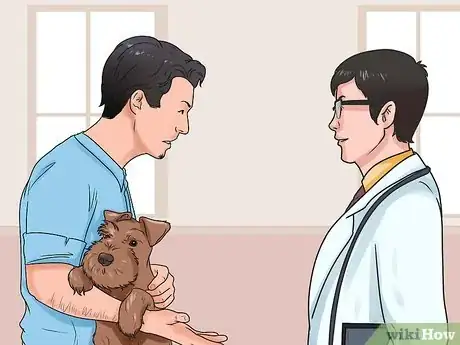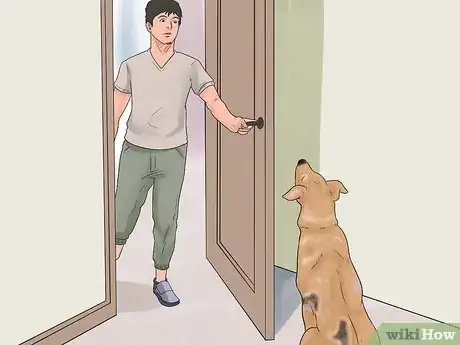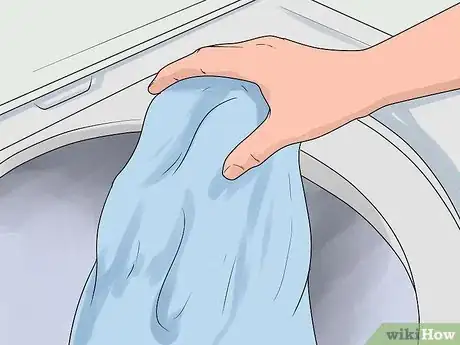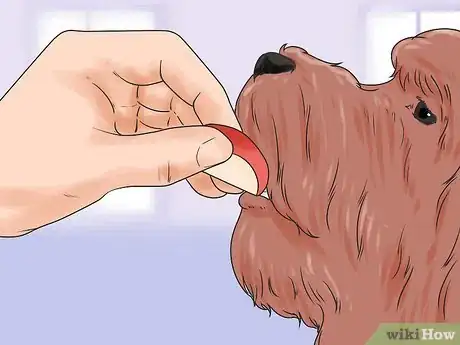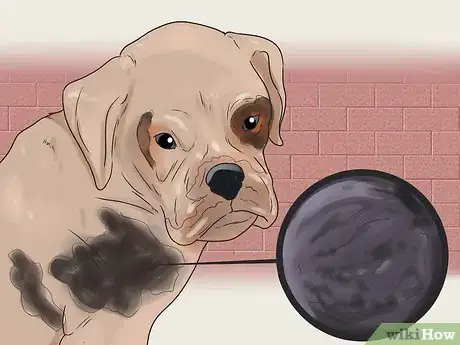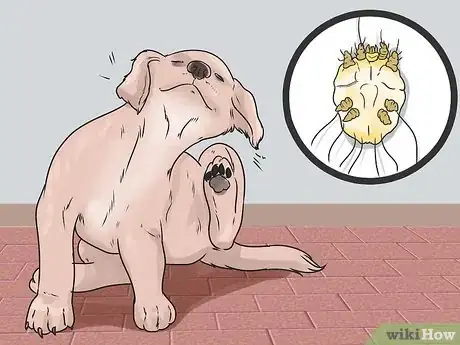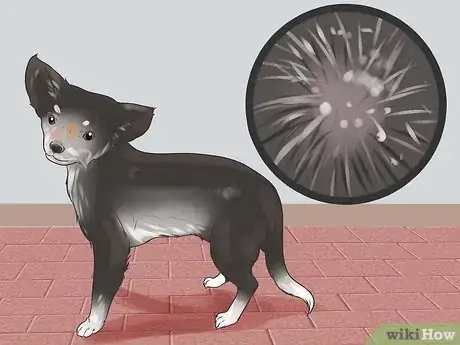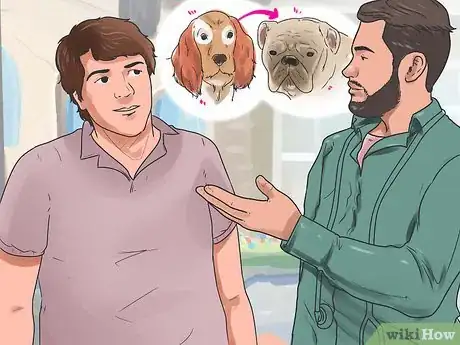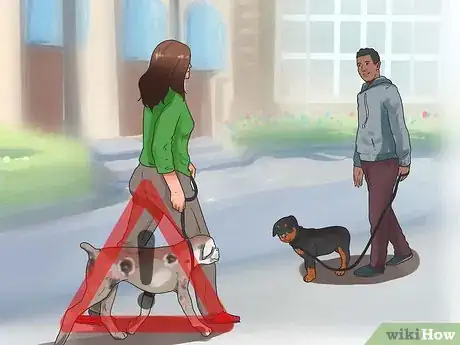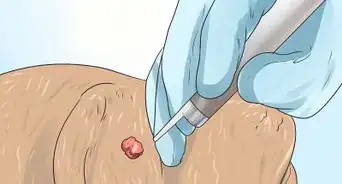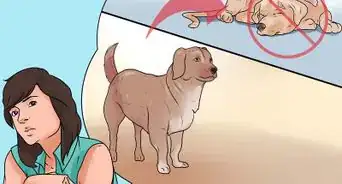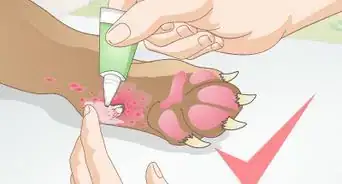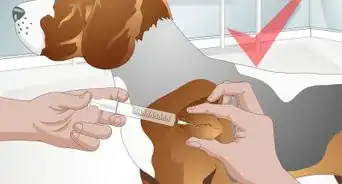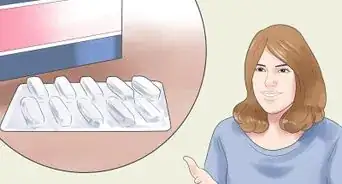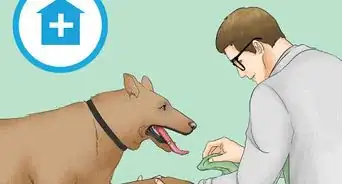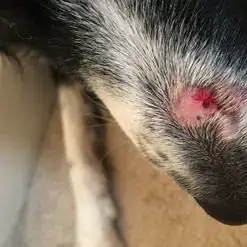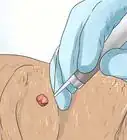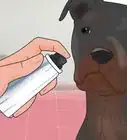This article was co-authored by Natalie Punt, DVM. Dr. Natalie Punt is a Veterinarian and the Founder and CEO of mPet- a smart phone app for pet owners to store, manage and transfer their pets medical records and health information. She specializes in small animal emergency and general medicine and veterinary practice economics. Dr. Punt holds a BS in Biochemistry and Molecular Biology from The University of California, Davis, an MS in Biochemistry from The University at Buffalo, and a DVM from Western University of Health Sciences.
wikiHow marks an article as reader-approved once it receives enough positive feedback. This article received 17 testimonials and 100% of readers who voted found it helpful, earning it our reader-approved status.
This article has been viewed 1,068,860 times.
Mange is a skin disease caused by mites that affects many animals. In dogs, it is caused by one of three microscopic mites: Cheyletiella, Demodex, or Sarcoptes.[1] Each one causes a different type of mange, with each presenting with similar yet varying degrees of symptoms. Because mange treatments vary by type and severity, it is essential to take your dog to a veterinarian if you suspect that he has mange. In the meantime, we'll help you treat your furry best friend's condition at home, identify the disease, and prevent it from happening again.
Things You Should Know
- Take your dog to a vet as soon as possible if you believe it may have mange.
- Administer medication according to your vet's advice, such as special baths or prescriptions.
- Isolate your dog from your other pets to prevent the mange from spreading.
- Wash and replace any bedding or fabrics your dog may have touched.
Steps
Treating Mange
-
1Bring your dog to the vet. If you suspect that your dog has mange, the first thing you should do is take him to the veterinarian. Treatments vary for the different types of mange and some medications can be toxic, so it is best to obtain an accurate diagnosis from a veterinarian who can advise you on the right course of treatment.[2]
- The process for diagnosing mange will vary from case to case. In some instances, the vet will be able to take a skin scraping from the affected area and analyze it under the microscope to look for mites or eggs.
- In situations where the mites are buried within the dog's skin -- such as in demodectic pododermatitis -- the vet may have to perform a deep biopsy to confirm the presence of mange.
- The vet will also perform a physical exam and take your pet's general health and history into account when making a diagnosis.
-
2Isolate your dog to prevent the mange from spreading to other pets. If your dog has mange, you should keep him away from any other pets you have to prevent them from becoming infected as well. Make sure that your dog is safe and warm. Do not isolate your dog by tying him outside or keeping him in an unheated space in the winter. Select a room in your house to keep him while you are treating him for mange.[3]
- Provide food, water, bedding, and toys for your dog while he is in isolation. Make sure that you spend time with him, take him for walks, and play with him so that he is not frightened by the isolation.
- In rare cases, humans may become infected with the mites that cause mange in dogs. Protect yourself by wearing gloves when you administer treatments to your dog.[4]
- You don't need to isolate your dog if it has demodex, as this is not highly infectious.
Advertisement -
3Administer medications and other treatments as instructed by your veterinarian. Your dog’s treatment will depend on the type of mange he has and this can only be determined with certainty by a licensed veterinarian.[5] Some dogs will need special baths, prescription medications, or even injections to treat their mange. Make sure that you follow the veterinarian’s instructions for treating your dog and contact your vet if you have any questions or concerns. Do not attempt to diagnose and treat your dog without the help of a veterinarian.[6]
-
4Wash or replace bedding and other items that come in close contact with your dog. In order to prevent mites from hiding out on your dog’s bedding or collar, you should remove these items and replace them.[7] Change and wash your dog’s bedding daily to keep it free from mites. Use hot water, soap, and bleach to thoroughly cleanse your dog’s bedding.
-
5Help your dog to manage psychological stress during mange treatment. Mange can cause dogs to become stressed because of the itching, isolation, vet visits, medications, and other treatments that they receive to treat their mange. As your dog goes through his treatment, make sure to do things that will help to keep him calm.[8]
- For example, you can provide him with a treat after he has had a bath, make sure that you visit him often while he is in isolation, and do things that you normally do together like going for walks and playing in the backyard.
Identifying Mange
-
1Look for symptoms of demodectic mange.[9] Demodectic mange is characterized by thinning patches of hair that can scab over. They can be localized in one area or spread throughout the body. Demodectic mange is not contagious and cannot be transferred to humans.
- Demodectic mange -- also known as demodex or "red mange" -- is caused by mites that are transferred from mother to puppy during the first few days of life. These mites are present in all dogs and usually won't cause any problems.
- Mange occurs when mite populations proliferate in dogs with underdeveloped immune systems -- like puppies under the age of 18 months, older dogs and dogs with compromised immune systems.
- When the mites are concentrated in one or two isolated patches on the skin, this is known as localized demodectic mange, which presents as bald scaly patches, usually on the dog's face. Localized demodectic mange is most common in puppies and will usually clear up on its own with no need for treatment.
- When the mange is present in large patches or all over the dog's body, this is known as generalized demodectic mange. This type of mange produces bald, scaly patches of skin, which can be very itchy. When the dog scratches, sores can form which are susceptible to unpleasant-smelling bacterial infections. Generalized demodectic mange is most common in dogs with compromised immune systems and will require treatment.
- The most resistant form of demodectic mange is known as demodectic pododermatitis, which occurs only in the feet and is accompanied by bacterial infection. This type of mange is difficult to diagnose and treat.[10]
-
2Look for symptoms of sarcoptic mange. Sarcoptic mange symptoms are similar to those of a flea infestation, and involve excessive biting and scratching at the skin, thinning of the hair and hair loss and open sores.
- Sarcoptic mange -- also known as canine scabies -- is caused by microscopic mites that are easily transferred from host to host, including humans (where it causes a red bumpy rash, similar to mosquito bites).
- In dogs, symptoms of sarcoptic mange usually develop about one week following exposure. The dog may become restless and start scratching frantically, before scaly, bald patches start appearing on its face, elbows, ears and legs.
- If the mange is not treated immediately, it may spread all over the dog's body and become more resistant to treatment.[11]
-
3Look for symptoms of cheyletiella mange. Cheyletiella mange is caused by large, white mites which live on the surface of the skin and is characterized by a red bumpy rash and scaly, flaky skin in the hair along the dog's neck and spine.
- This type of mange is also known as "walking dandruff." The mites themselves that look like flakes of dandruff, so the "walking dandruff" is the mites moving around.
- Cheyletiella mange is highly contagious to other dogs (especially puppies) and can cause intense itching (although sometimes itching is completely absent). It is usually passed from puppy to puppy as a result of mite infestations in straw and animal bedding in pet shops and kennels.
- Cheyletiella mange can also be passed on to humans, causing an itchy, bumpy red rash on the arms, trunk and buttocks. However, the symptoms should disappear once the puppy has been treated, as the mites can't survive without a host for more than 10 days.
- However, as the use of straw in animal bedding is becoming less common and the use of flea-control preparations had risen, instances of cheyletiella mange are becoming less and less frequent.[12]
Preventing Recurrence
-
1Treat other animals your pet has come in contact with. If your dog was infected with either sarcoptic or cheyletiella mange, you will need to treat any dogs or other animals that your pet is in frequent contact with -- otherwise he could be re-infected. Talk to your vet about how to treat your other pets to avoid a recurrence of mange in your dog.
-
2Keep your dog away from other dogs who may be infected. If you suspect that a dog (or cat) in your neighborhood may have mange, you should keep your dog as far away from the animal as possible.[13] Talk to the animal’s owner to let them know that you think their pet has mange or call animal control if the animal is a stray.
-
3Take your dog to the vet for regular check-ups. Following treatment, you should bring your dog back to the vet for periodic check-ups. The veterinarian can analyze skin scrapings to confirm that the mites have not returned. Do not attempt to treat a recurrence of mange without consulting your veterinarian first because some treatments can be toxic if used more than once in too short of a time period.[11]
Expert Q&A
-
QuestionCan senior dogs get Demodex?
 Natalie Punt, DVMDr. Natalie Punt is a Veterinarian and the Founder and CEO of mPet- a smart phone app for pet owners to store, manage and transfer their pets medical records and health information. She specializes in small animal emergency and general medicine and veterinary practice economics. Dr. Punt holds a BS in Biochemistry and Molecular Biology from The University of California, Davis, an MS in Biochemistry from The University at Buffalo, and a DVM from Western University of Health Sciences.
Natalie Punt, DVMDr. Natalie Punt is a Veterinarian and the Founder and CEO of mPet- a smart phone app for pet owners to store, manage and transfer their pets medical records and health information. She specializes in small animal emergency and general medicine and veterinary practice economics. Dr. Punt holds a BS in Biochemistry and Molecular Biology from The University of California, Davis, an MS in Biochemistry from The University at Buffalo, and a DVM from Western University of Health Sciences.
Veterinarian Not usually! Some of their skin is really good at getting rid of any harmful bacteria, mites, or parasites. So, it's definitely not normal if you see a mature dog with Demodex.
Not usually! Some of their skin is really good at getting rid of any harmful bacteria, mites, or parasites. So, it's definitely not normal if you see a mature dog with Demodex. -
QuestionI am treating my dog for demodectic mange on her paws with an aludex bath every three to five days. Is there anything else I can do to help her?
 Pippa Elliott, MRCVSDr. Elliott, BVMS, MRCVS is a veterinarian with over 30 years of experience in veterinary surgery and companion animal practice. She graduated from the University of Glasgow in 1987 with a degree in veterinary medicine and surgery. She has worked at the same animal clinic in her hometown for over 20 years.
Pippa Elliott, MRCVSDr. Elliott, BVMS, MRCVS is a veterinarian with over 30 years of experience in veterinary surgery and companion animal practice. She graduated from the University of Glasgow in 1987 with a degree in veterinary medicine and surgery. She has worked at the same animal clinic in her hometown for over 20 years.
Veterinarian Make sure she is eating a good balanced diet to strengthen her immune system and help her skin fight off the mites. Aludex is a treatment designed to kill demodex mites, and demodectic mange is relatively unusual in adult dogs. Your vet may need to investigate to see if the dog has an underlying health problem that is suppressing the immune system and allowing the demodex mites to breed in her skin.
Make sure she is eating a good balanced diet to strengthen her immune system and help her skin fight off the mites. Aludex is a treatment designed to kill demodex mites, and demodectic mange is relatively unusual in adult dogs. Your vet may need to investigate to see if the dog has an underlying health problem that is suppressing the immune system and allowing the demodex mites to breed in her skin. -
QuestionDoes Amitraz work for both types of mange?
 Pippa Elliott, MRCVSDr. Elliott, BVMS, MRCVS is a veterinarian with over 30 years of experience in veterinary surgery and companion animal practice. She graduated from the University of Glasgow in 1987 with a degree in veterinary medicine and surgery. She has worked at the same animal clinic in her hometown for over 20 years.
Pippa Elliott, MRCVSDr. Elliott, BVMS, MRCVS is a veterinarian with over 30 years of experience in veterinary surgery and companion animal practice. She graduated from the University of Glasgow in 1987 with a degree in veterinary medicine and surgery. She has worked at the same animal clinic in her hometown for over 20 years.
Veterinarian Yes. Amitraz has a good spectrum of activity and kills both sarcoptic and demodectic mange mites, plus cheyletiella (the 'walking dandruff' mite) and ticks.
Yes. Amitraz has a good spectrum of activity and kills both sarcoptic and demodectic mange mites, plus cheyletiella (the 'walking dandruff' mite) and ticks.
Warnings
- Always wear gloves when using a dip, and don't wear any jewelry or good clothing.⧼thumbs_response⧽
References
- ↑ Natalie Punt, DVM. Veterinarian. Expert Interview. 15 February 2022.
- ↑ https://www.aspca.org/pet-care/dog-care/mange
- ↑ https://www.aspca.org/pet-care/dog-care/mange
- ↑ http://www.petmd.com/dog/general-health/evr_dg_demodectic_mange_in_dogs
- ↑ Natalie Punt, DVM. Veterinarian. Expert Interview. 15 February 2022.
- ↑ https://www.aspca.org/pet-care/dog-care/mange
- ↑ https://www.aspca.org/pet-care/dog-care/mange
- ↑ http://pets.webmd.com/dogs/mange-dogs-canine-scabies?page=2
- ↑ Natalie Punt, DVM. Veterinarian. Expert Interview. 15 February 2022.
About This Article
To cure mange in dogs, start by isolating your dog to prevent the mange from spreading to any other pets in the house. Next, take your furry friend to a veterinarian to confirm the diagnosis and get professional advice about the best course of treatment. Be sure to administer medications and other prescribed treatments exactly as instructed by your veterinarian. Additionally, wash your dog's bedding with hot water, soap, and bleach and replace it with fresh bedding daily to get rid of the mites that cause mange. For tips on preventing mange from reoccurring, read on!

